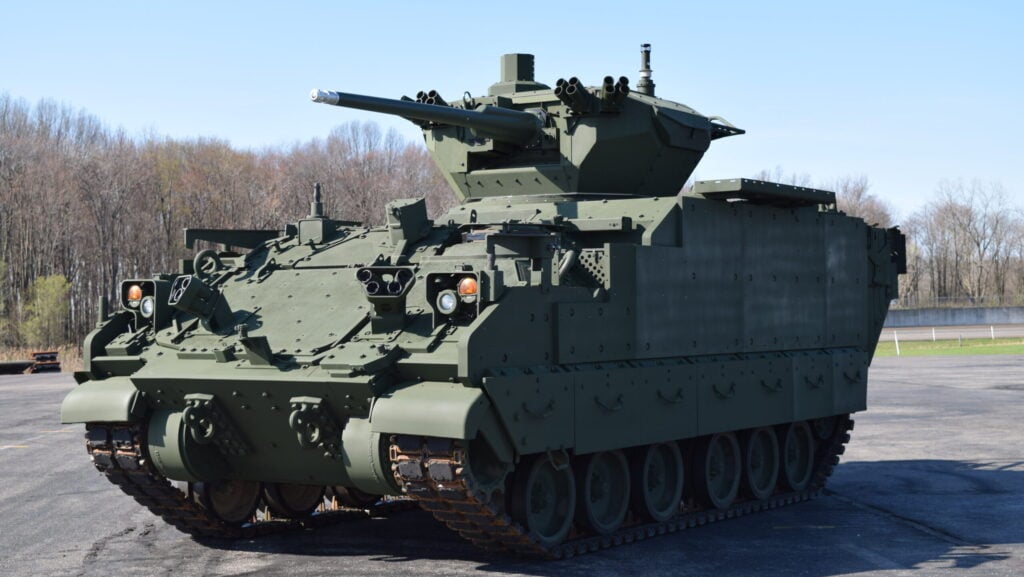BAE Systems’ showcased its fourth AMPV prototype at Eurosatory, this one featuring a 30mm cannon from Oshkosh Defense that is part of the US Army’s Medium Caliber Weapon System program. (BAE Systems)
PARIS — As BAE Systems ramps up Armored Multi-Purpose Vehicle (AMPV) production to meet US Army demand, company leaders eyeing possible international sales say they’re actually aiming to produce 220 vehicles per year at the York, Pa. facility.
AMPV program director Bill Sheehy and international business development director for Europe Paul Zukowski were at Eurosatory last week and spoke with a handful of reporters about the M113 armored personnel carrier replacement program, work with the US Army and possible new customers.
Around the March timeframe, BAE Systems kicked off a year-long production ramp up plan that would increase production from about one brigade set per year (approximately 130 vehicles) up to a brigade-and-a-half (in the neighborhood of 195-197 vehicles).
While work is underway to achieve those previously disclosed goals, Sheehy said the company is “looking well beyond” the Army’s current demand and would ideally like to produce 220 AMPVs at the York facility each year. Doing so, he said, would enable the company to meet current contract obligations, as well as new ones from the US Army and international customers.
“I do anticipate either new vehicles coming down the pike, whether it’s … command [and] control, or counter [unmanned aerial systems] UAS or whatever you want to call it: I do anticipate the family growing,” Sheehy told reporters. “But I also anticipate interest from the rest of the world to replace their M113.”
The Army’s current AMPV plan currently revolves around five vehicle configurations: general purpose, mission command, mortar carriers, medical evacuation and medical treatment. However, the service is eyeing additional configurations including using the platform as the crewed control vehicle for Robotic Combat Vehicles. According to Sheehy, BAE and the Army have now begun conversations creating such a variant.
The company has also been touting its universal top plate system as an avenue for rolling out new configurations like a prototype with the Kongsberg-Patria NEMO remote-controlled 120mm turreted mortar system.
“There are a number of things [coming out of Ukraine] that they’re talking to us about,” Sheehy said.
“One of the lessons learned is counter-battery threats to artillery or mortars, and [when] you are stationary when they fire, that turreted mortar capability allows the vehicle to fire while moving, which … reduces counter-battery [threats],” he later added.
At the service behest, the company produced that turreted mortar prototype and soldiers have been testing it out this month at Yuma Proving Ground in Arizona before it heads to Ft. Moore in Georgia for a demonstration later this summer, according to Sheehy.
“They’re paying for it, and they are evaluating that technology,” he added, noting there are other turreted motors out there that could also be integrated onto the AMPV.
“Our job, again, is to be prepared whichever way they want to go,” he added. In addition to producing that prototype, the company has created several others. Last week at the European arms show, it showcased an AMPV with a 30mm cannon configuration from Oshkosh Defense that is part of the Army’s upgunned Stryker program, also dubbed the Medium Caliber Weapon System.
Looking beyond the US market, Zukowski said the company is having active conversations with Romania about AMPV options within their military, and as Poland acquires M1 Abrams main battle tanks, the AMPV mission command and medivac variants would be a “good fit” to support those tanks.
“While Poland [and] Romania are obviously front leaders in this piece of the discussion with us, anyone who owns M113s, I think, should be talking about AMPVs coming in and replacing those mission goals,” Zukowski added.
Circling back to production capacity, though, the duo said the York facility could handle a few smaller orders from foreign militaries but if a larger order is placed or for multiple variants, setting up local production would be a viable option.





















Discussion about this post